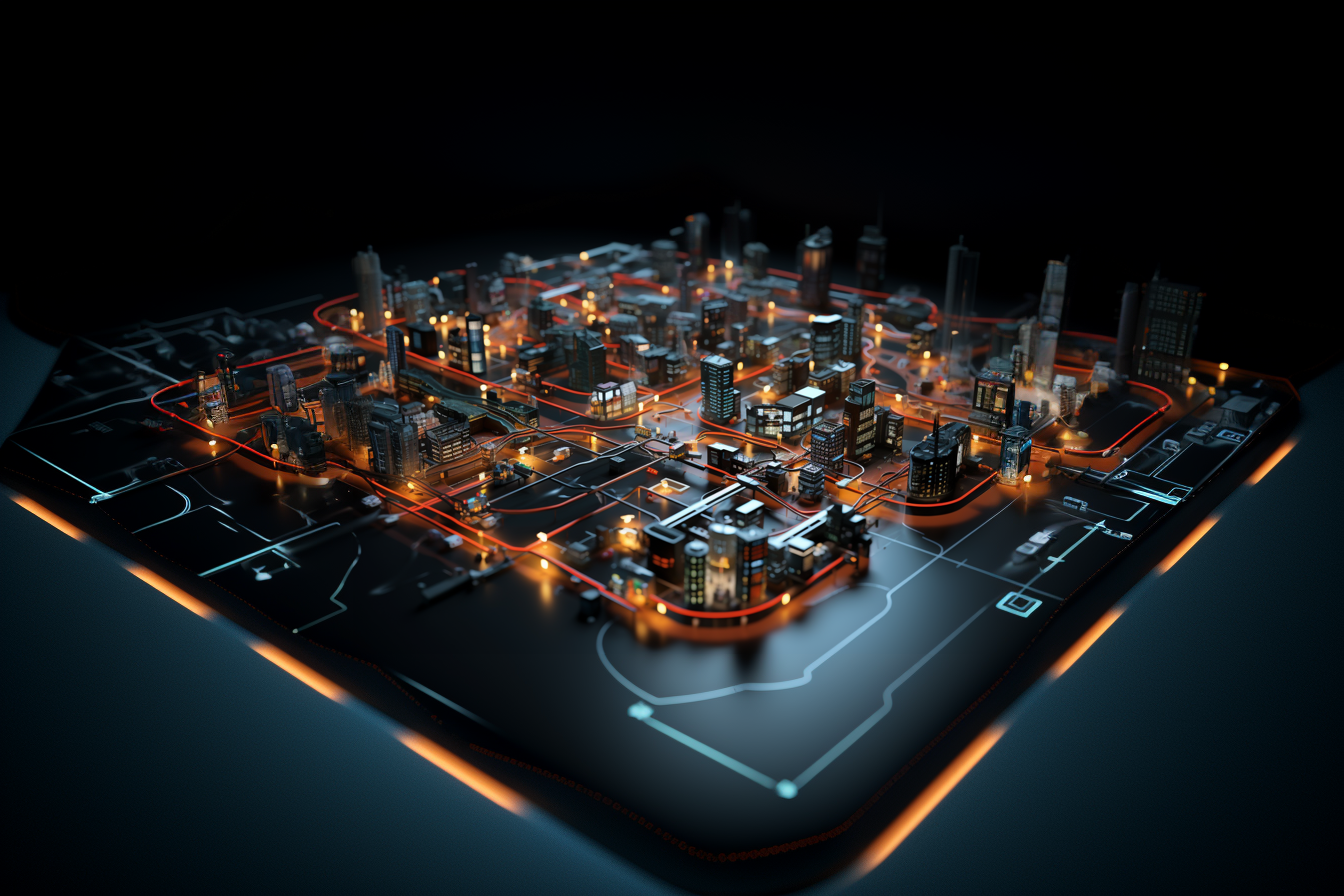Why every organisation needs the power of a digital twin

In this fast-paced digital age, companies are always on the hunt for innovative ways to streamline their operations, boost productivity and carve out a competitive edge. Among the emerging technologies gaining ground, one concept stands out – the 'digital twin'. Traditionally, this is a virtual double of a physical object or system, offering a real-time reflection of its real-world mate. But its potential doesn't stop at tangible assets.
Listen to this article:
Welcome to the era of the 'digital twin brain', a pioneering idea that applies digital twin principles to the very structures of businesses.
Imagine having a comprehensive digital representation of your entire organisation, mirroring not just the physical infrastructure, but the people, processes and systems that make it tick. A digital twin brain does exactly that, modelling each department, role and workflow, to produce an intricate digital echo of the organisation. This simulation opens up possibilities for real-time monitoring, analysis and enhancement of operations - an exciting opportunity for any business.
The potential benefits of embracing digital twin technology are wide-ranging, from increased operational efficiency and better-informed decision-making, to future-proofing your business.
Knowledge is Power
In the heart of the digital twin brain lies one essential component: knowledge. Every piece of data, every decision made, every action taken within an organisation can be translated into knowledge. This invaluable asset is the lifeblood of any digital twin brain. By creating a comprehensive model of an organisation, everyone - from top-tier management to entry-level employees - can interact with, contribute to, and gain insight from this knowledge base.

The beauty of a digital twin brain lies in its ability to assimilate information from a wide array of sources, making it a hub of diverse knowledge. It captures the unique perspectives and insights from every corner of an organisation and embeds these into the digital framework. This model doesn't just reflect the what, but also the how and why of business operations, encapsulating the full depth and breadth of an organisation's knowledge.
The principle of a digital twin brain is rooted in the democratisation of knowledge. Traditionally, certain information might be siloed within specific departments or roles. But with a digital twin, all relevant information becomes accessible to everyone in the organisation. The sharing of knowledge becomes a two-way street, fostering a more collaborative and transparent working environment. It's about empowering everyone to contribute their unique knowledge and perspectives to the organisation's collective intelligence.
What sets a digital twin brain apart is not just the wealth of knowledge it holds, but also the flexible way it allows individuals to interact with this information. Given the diverse range of roles and responsibilities within any organisation, a one-size-fits-all approach to data simply won't cut it. A digital twin brain accommodates this diversity by enabling personalised inputs and outputs.
Employees can feed information into the digital twin in ways that suit their roles and workflows best. Simultaneously, they can access and interpret the organisation's knowledge in a way that is most meaningful to them. For instance, a data analyst might prefer visualising data in detailed charts and graphs, while a project manager might favour Gantt charts or Kanban boards to track project progress. By facilitating tailored interaction, a digital twin brain ensures that everyone can maximise the utility of the knowledge base, leading to better decision-making and improved overall performance.
In the world of digital twin brains, knowledge truly is power. It fuels the digital model, enriches the organisational understanding and fosters a more inclusive, collaborative environment. With everyone able to input and output knowledge in the most suitable way for them, it's a win-win situation for individuals and the organisation alike.
Empowering Employees
Digital twin brains hold great potential to revolutionise the way organisations function. By creating a digital echo of each role, department, and process, these systems not only optimise operations but also empower employees, leading to increased productivity and human-centric work.
Digital twin brains can be a catalyst for employee empowerment. By giving individuals the opportunity to input their knowledge and insights into the system, they feel valued and acknowledged. It's no longer just about following directives from the top down; it's about harnessing the collective intelligence of all staff members.
Through access to the wealth of knowledge within the digital twin, employees can also take initiative in their work, make informed decisions, and innovate in their roles. They are equipped with the necessary information to understand the broader business context, see the potential impact of their actions, and hence, contribute more effectively to the organisation's goals.
One of the critical benefits of a digital twin brain is its potential to enhance productivity. By modelling every process, role, and department, the digital twin brain provides a holistic view of the organisation, making it easier to identify bottlenecks, inefficiencies, or areas for improvement. The system allows for real-time monitoring and assessment, enabling swift action to optimise workflows and boost productivity.
Moreover, by automating routine tasks and data processing, the digital twin brain frees up employees to focus on more complex, high-value tasks. It takes care of the heavy lifting, allowing staff to concentrate their efforts where human intelligence and creativity make the most difference.
Perhaps the most promising aspect of implementing a digital twin brain is its potential to enable more human-centric work. As automation takes over routine, mundane tasks, employees have more time to engage in meaningful work that plays to their strengths and interests. This shift can lead to greater job satisfaction, better work-life balance, and increased employee retention.
In the era of AI and automation, human skills such as creativity, problem-solving, and emotional intelligence are more valuable than ever. A digital twin brain can help organisations leverage these unique human abilities. By freeing up their time, employees can focus on building relationships, innovating, and enhancing their skills, thus contributing to an enriching work environment and a more robust organisation.
Competitive Superpower
It goes without saying that implementing a digital twin brain can make an organisation faster by optimising operations and automating tasks. But beyond these immediate benefits, a digital twin brain offers a more profound advantage: the ability to run simulations and foresee different outcomes. This predictive capability, akin to having a crystal ball, could be the silver bullet that sets an organisation miles ahead of its competition.

A digital twin brain can store and process vast amounts of data, tracking the interactions and operations of every department, role, and workflow within an organisation. This data forms the basis for running sophisticated simulations that can predict the impact of changes on an organisational level. Imagine being able to anticipate the outcomes of implementing a new business strategy, launching a product, or changing a workflow. It gives organisations a strategic edge, enabling them to act proactively rather than reactively.
Simulations run by a digital twin brain can help identify opportunities for growth and improvement. For example, they could highlight a particular process that, if optimised, could significantly boost productivity or pinpoint a market trend that the organisation could capitalise on. At the same time, these simulations can flag potential challenges before they become problematic. By predicting future hurdles, organisations can devise strategies to navigate them successfully, further reinforcing their competitive position.
The ability to foresee outcomes significantly enhances decision-making. Leaders can base their decisions on a clear understanding of the potential impacts, reducing uncertainty and risk. This transparency fosters a more confident, decisive organisational culture. It also enables teams to rally behind decisions, knowing that they are backed by solid data and forward-thinking analysis.
In an ever-changing business environment, resilience is key to survival and success. With the power to run simulations and foresee outcomes, a digital twin brain can help build organisational resilience. By regularly testing different scenarios, companies can prepare for a range of possibilities, ensuring they are never caught off guard. It's like having a 'Plan B' (and 'C', and 'D') at the ready, ensuring the organisation can weather any storm.
In essence, the speed and efficiency gained from implementing a digital twin brain are undoubtedly beneficial. Still, it's the capability to run models and predict different outcomes that provides the real competitive edge - the silver bullet in an organisation's arsenal. With this power, businesses can navigate the future with confidence, making strategic decisions that propel them ahead in the game.
Breaking it down into models
While creating an overarching digital twin brain for an entire organisation is a significant step towards innovation, breaking down this model to represent individual roles, departments, and even the nuances of organisational structure offers an entirely new dimension of benefits. The meticulous detail involved in modelling every aspect of an organisation ensures a comprehensive understanding that is tailored to the uniqueness of each entity within the company.

Individual Roles
Personalised Insights: By creating a digital twin for every role, the organisation can gain nuanced insights into the unique requirements, challenges, and contributions of each position. It provides a platform for employees to communicate their individual needs and feedback more effectively.
Skill Development: A detailed model of each role helps in identifying the specific skills and competencies required, leading to more targeted training and development. This investment in human capital can boost both employee satisfaction and organisational efficiency.
Enhanced Collaboration: Understanding the specific roles of different employees fosters a more empathetic and collaborative workplace. Colleagues are better able to appreciate each other's contributions, leading to improved teamwork.
Comprehensive Modelling of Departments
Holistic View: Modelling individual departments provides a bird's-eye view of the organisational structure. It helps in identifying the interconnections and dependencies between different departments, enhancing cooperation and coordination.
Targeted Improvement: By examining each department through the lens of a digital twin, inefficiencies and areas for growth can be spotted and addressed more precisely. It also helps in aligning departmental goals with the broader organisational objectives.
Strategic Resource Allocation: Understanding the functioning and needs of different departments allows for smarter resource allocation. It ensures that each department is equipped with the necessary tools, personnel, and budget to thrive.
Reflecting Organisational Structure
Accurate Representation: By modelling the entire organisational structure, the digital twin brain captures the complexity and hierarchy of the company. It reflects the company's values, culture, and working philosophy.
Flexibility and Adaptation: Such a detailed model allows for more flexible strategic planning. It enables the organisation to run simulations that consider various structural scenarios, helping them adapt to changing market dynamics and internal shifts.
Organisational Alignment: With a clear digital map of the organisational structure, alignment between various levels and sectors of the business can be more easily achieved. It ensures that everyone is moving in the same direction, with a shared vision and understanding.
The meticulous process of creating model representations of each role, department, and the entire organisational structure provides an unparalleled understanding of the business's inner workings. It's not merely a technological feat but a strategic approach that binds the organisation together, facilitating growth, collaboration, and resilience. By embracing this level of detail, organisations are placing themselves at the forefront of innovation, ready to compete with more AI-driven entities and equipped to understand the best operating approach for their unique ecosystem.
Where to start
The implementation of a digital twin brain within an organisation is undeniably an ambitious endeavour. The idea of creating a digital mirror for every role, department, and organisational structure may seem overwhelming. Yet, the beauty of this innovation lies in its scalability.
Organisations don't need to leap into a complete overhaul; they can start small, even with something as singular as a specific project or role, and still see significant value.
Elevate your organisation's digital transformation journey with our cutting-edge Digital Twin technology. Experience innovation like never before by creating your organisation's digital twin brain.
For enquiries or to kick-start your journey, connect with us at [email protected]. Start making smarter decisions, faster - your digital future awaits!
